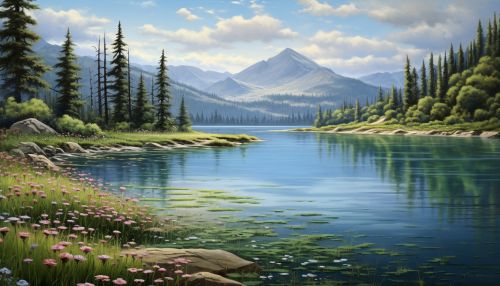Lakes
Introduction
A lake is a large body of water that has accumulated in a natural basin or depression on the Earth's surface, typically filled with freshwater. Lakes are distinct from other bodies of water such as oceans, rivers, and ponds due to their size and the nature of their formation. They play a crucial role in the Earth's hydrological cycle, acting as reservoirs for water and influencing local and regional climates.


Formation of Lakes
Lakes can form through a variety of geological processes. Some of the most common processes include tectonic activity, glacial activity, volcanic activity, and erosion.
Tectonic Lakes
Tectonic lakes are formed due to movements within the Earth's crust. These movements can create depressions or basins where water can accumulate. Examples of tectonic lakes include the Caspian Sea and the Great Rift Valley lakes in Africa.
Glacial Lakes
Glacial lakes are formed by the action of glaciers and ice sheets. As glaciers move, they carve out depressions in the landscape. When the glaciers melt, these depressions fill with water, forming lakes. Examples of glacial lakes include the Great Lakes of North America and many of the lakes in the Swiss Alps.
Volcanic Lakes
Volcanic lakes are formed in the craters of dormant or extinct volcanoes. When a volcano erupts, it can leave behind a large crater. Over time, this crater can fill with water, forming a lake. Examples of volcanic lakes include Crater Lake in the United States and Lake Taupo in New Zealand.
Erosion Lakes
Erosion lakes are formed by the action of water or wind eroding the landscape. This erosion can create depressions where water can accumulate. Examples of erosion lakes include the Great Salt Lake in the United States and the Dead Sea in the Middle East.
Characteristics of Lakes
Lakes can vary greatly in their physical and chemical characteristics. These characteristics can include the lake's size, depth, temperature, salinity, and nutrient content.
Size and Depth
The size and depth of a lake can have a significant impact on its physical and biological characteristics. Larger and deeper lakes tend to have more stable temperatures and can support a greater diversity of life.
Temperature
The temperature of a lake can vary depending on its depth, the time of year, and the local climate. Most lakes have a thermocline, a layer of water where the temperature changes rapidly with depth.
Salinity
The salinity of a lake refers to the amount of dissolved salts it contains. Some lakes, such as the Great Salt Lake and the Dead Sea, are highly saline, while others, such as the Great Lakes, are freshwater.
Nutrient Content
The nutrient content of a lake can influence its biological productivity. Lakes with high nutrient levels can support large populations of plants and animals, while those with low nutrient levels may be less productive.
Lake Ecosystems
Lakes are home to a diverse range of organisms, from tiny microorganisms to large mammals. These organisms interact with each other and their environment in complex ways, forming intricate ecosystems.
Flora
The flora of a lake can include a wide variety of plants, from floating algae to rooted aquatic plants. These plants play a crucial role in the lake ecosystem, providing food and habitat for other organisms and helping to regulate the lake's nutrient levels.
Fauna
The fauna of a lake can include a diverse range of animals, from tiny invertebrates to large mammals. These animals depend on the lake for food, water, and habitat.
Microorganisms
Microorganisms, including bacteria, archaea, and protists, play a crucial role in the lake ecosystem. They help to break down organic matter and recycle nutrients, and some can even photosynthesize, producing oxygen.
Human Use and Impact
Humans have used lakes for thousands of years for a variety of purposes, including water supply, irrigation, fishing, transportation, recreation, and power generation. However, human activities can also have a significant impact on lakes and their ecosystems.
Pollution
Pollution is a major threat to many lakes around the world. Sources of pollution can include industrial waste, agricultural runoff, and residential sewage. This pollution can harm the lake's ecosystems and make the water unsafe for human use.
Invasive Species
Invasive species can also pose a threat to lake ecosystems. These species can outcompete native species for resources, disrupt food chains, and alter the physical characteristics of the lake.
Climate Change
Climate change can have a significant impact on lakes. Rising temperatures can lead to changes in lake temperature and ice cover, which can in turn affect the lake's ecosystems. Changes in precipitation patterns can also affect lake water levels and salinity.
